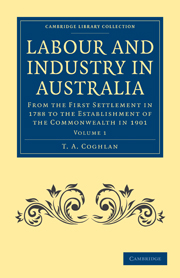 Labour and Industry in Australia
Labour and Industry in Australia Book contents
- Frontmatter
- PREFACE
- Contents
- PART I FROM THE FOUNDATION OF SETTLEMENT TO THE CROSSING OF THE MOUNTAINS
- PART II FROM THE CROSSING OF THE MOUNTAINS TO THE ABOLITION OF THE ASSIGNMENT SYSTEM
- PART III FROM THE ABOLITION OF THE ASSIGNMENT SYSTEM TO THE DISCOVERY OF GOLD
- I INTRODUCTION TO THE THIRD PERIOD
- II TRANSPORTATION
- III IMMIGRATION
- IV LAND LEGISLATION IN NEW SOUTH WALES, VAN DIEMEN'S LAND, AND WESTERN AUSTRALIA
- V LAND LEGISLATION AND SETTLEMENT IN SOUTH AUSTRALIA AND THE WAKEFIELD THEORY OF COLONIZATION
- VI LABOUR AND WAGES
- VII PRICES
- VIII FINANCIAL CRISIS OF 1841, 1842, AND 1843
- IX INDUSTRIES
- PART IV FROM THE DISCOVERY OF GOLD TO THE INTRODUCTION OF FREE SELECTION OF LAND BEFORE SURVEY
IV - LAND LEGISLATION IN NEW SOUTH WALES, VAN DIEMEN'S LAND, AND WESTERN AUSTRALIA
Published online by Cambridge University Press: 05 August 2011
- Frontmatter
- PREFACE
- Contents
- PART I FROM THE FOUNDATION OF SETTLEMENT TO THE CROSSING OF THE MOUNTAINS
- PART II FROM THE CROSSING OF THE MOUNTAINS TO THE ABOLITION OF THE ASSIGNMENT SYSTEM
- PART III FROM THE ABOLITION OF THE ASSIGNMENT SYSTEM TO THE DISCOVERY OF GOLD
- I INTRODUCTION TO THE THIRD PERIOD
- II TRANSPORTATION
- III IMMIGRATION
- IV LAND LEGISLATION IN NEW SOUTH WALES, VAN DIEMEN'S LAND, AND WESTERN AUSTRALIA
- V LAND LEGISLATION AND SETTLEMENT IN SOUTH AUSTRALIA AND THE WAKEFIELD THEORY OF COLONIZATION
- VI LABOUR AND WAGES
- VII PRICES
- VIII FINANCIAL CRISIS OF 1841, 1842, AND 1843
- IX INDUSTRIES
- PART IV FROM THE DISCOVERY OF GOLD TO THE INTRODUCTION OF FREE SELECTION OF LAND BEFORE SURVEY
Summary
The agrarian movements of this period are particularly interesting: in New South Wales there was the struggle between the squatters and the Governor, which gave victory for the time being to the former; in South Australia the Wakefield theory had its first opportunity of being shown to the world in operation, and in Western Australia the colonists had to face the problems arising out of the alienation of land in large blocks without corresponding settlement.
Allusion has been made to the ineradicable tendency of the colonists in New South Wales to push out into the unknown regions of the north and west, in search of land better than they saw around them in the settled districts, and the efforts of the Government to check their dispersion. The policy of the Governors had been, from the beginning, to mark out a defined area for colonization and endeavour to restrict settlement to that area until it was fairly well occupied; then in an orderly way to throw open another area and proceed to its occupation. That this policy could not be carried out, after the passage of the mountains had opened illimitable fields to the enterprise of the settlers, never seems to have been fully realized in England; and when Lord Glenelg, who presided over the Colonial Office from 1835 to 1839, gave his attention to the land question, he thought he saw, in the low price at which land was being sold in New South Wales, an incitement to the colonists to disperse themselves unduly, which would be checked by raising the minimum price to 12s. an acre.
- Type
- Chapter
- Information
- Labour and Industry in AustraliaFrom the First Settlement in 1788 to the Establishment of the Commonwealth in 1901, pp. 377 - 403Publisher: Cambridge University PressPrint publication year: 2011First published in: 1918


